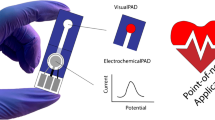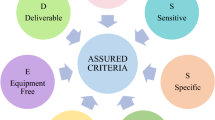Abstract
Paper-based analytical devices (PADs) have encountered a wealth of applications in recent years thanks to the numerous advantages of paper as a support. A silver nanoflower (AgNF) modified paper-based dual substrate for both surface-enhanced Raman spectroscopy (SERS) and ambient pressure paper spray mass spectrometry (PS-MS) was developed. AgNFs were immobilized on nylon-coated paper modified with silver and ethylenediamine. The developed substrate was characterized via scanning electron microscopy and infrared spectroscopy. The densely packed nanoscale petals of the AgNFs lead to a large number of so-called hot spots at their overlapping points, which result in an enhancement of the Raman signal. In addition, the presence of the AgNFs produces an increase in the sensitivity of the mass spectrometric analysis as compared with bare paper and nylon/Ag-coated paper. The dual substrate was evaluated for the identification and quantification of ketoprofen in aqueous standards as well as human saliva from healthy volunteers. The method enables the determination of ketoprofen with a limit of detection and limit of quantification via PS-MS of 0.023 and 0.076 mg L−1, respectively, with a relative standard deviation (RSD) of 3.4% at a concentration of 0.1 mg L−1. This dual substrate enables the simple and fast detection of ketoprofen with minimal sample preparation, providing complementary Raman and mass spectrometric information.

Graphical abstract





Similar content being viewed by others
References
Nery EW, Kubota LT. Sensing approaches on paper-based devices: a review. Anal Bioanal Chem. 2013;405(24):7673–595.
Díaz-Liñán MC, López-Lorente AI, Cárdenas S, Lucena R. Molecularly imprinted paper-based analytical device obtained by a polymerization-free synthesis. Sens Actuators B Chem. 2019;287:138–46.
Channon RB, Yang Y, Feibelman KM, Geiss BJ, Dandy DS, Henry CS. Development of an electrochemical paper-based analytical device for trace detection of virus particles. Anal Chem. 2018;90(12):7777–83.
Song W, Wang Y, Huang L, Cheng H, Wu J, Pan Y. Reactive paper spray mass spectrometry for rapid analysis of fomaldehyde in facial masks. Rapid Commun Mass Spectrom. 2019;33(12):1091–6.
Jang W, Byun H, Kim JH. Rapid preparation of paper-based plasmonic platforms for SERS applications. Mater Chem Phys. 2020;240:122124.
Ríos-Gómez J, Lucena R, Cárdenas S. Paper supported polystyrene membranes for thin film microextraction. Microchem J. 2017;133:90–5.
Hashemian Z, Khayamian T, Saraji M. Anticodeine aptamer immobilized on a Whatman cellulose paper for thin-film microextraction of codeine from urine followed by electrospray ionization ion mobility spectrometry. Anal Bioanal Chem. 2015;407:1615–23.
Ríos-Gómez J, Fresco-Cala B, García-Valverde MT, Lucena R, Cárdenas S. Carbon nanohorn suprastructures on a paper support as a sorptive phase. Molecules. 2018;23(6):E1252.
Tsai TT, Huang CY, Chen CA, Shen SW, Wang MC, Cheng CM, et al. Diagnosis of tuberculosis using colorimetric gold nanoparticles on a paper-based analytical device. ACS Sensors. 2017;2(9):1345–54.
Saraji M, Mehrafza N. Phenyl carbamate functionalized zinc oxide nanorods for paper-based thin film microextraction. RSC Adv. 2017;7:50210–5.
Zhang MR, Jiang QM, Wang ZG, Zhang SH, Hou F, Pan GB. Three-dimensional gallium nitride nanoflowers supports decorated by gold or silver nanoparticles to fabricate surface-enhanced Raman scattering substrates. Sens Actuators B Chem. 2017;253:652–9.
Bibikova O, Haas J, López-Lorente AI, Popov A, Kinnunen M, Meglinski I, et al. Towards enhanced optical sensor performance: SEIRA and SERS with plasmonic nanostars. Analyst. 2017;142:951–8.
Fikiet MA, Khandasammy SR, Mistek E, Ahmed Y, Halámková L, Bueno J, et al. Surface enhanced Raman spectroscopy: a review of recent applications in forensic science. Spectrochim Acta A Mol Biomol Spectrosc. 2018;197:255–60.
Roy S, Ajmal CM, Baik S, Kim J. Silver nanoflowers for single-particle SERS with 10 pM sensitivity. Nanotechnol. 2017;28:465705.
López-Lorente AI, Simonet BM, Valcárcel M, Mizaikoff B. Bare gold nanoparticles mediated surface-enhanced Raman spectroscopic determination and quantification of carboxylated single-walled carbon nanotubes. Anal Chim Acta. 2013;788:122–8.
Al-Shalalfeh MM, Onawole AT, Saleh TA, Al-Saadi AA. Spherical silver nanoparticles as substrates in surface-enhanced Raman spectroscopy for enhanced characterization of ketoconazole. Mater Sci Eng C Mater Biol Appl. 2017;76:356–64.
Bibikova O, Haas J, López-Lorente AI, Popov A, Kinnunen M, Ryabchikov Y, et al. Surface enhanced infrared absorption spectroscopy based on gold nanostars and spherical nanoparticles. Anal Chim Acta. 2017;990:141–9.
Aroca RF. Plasmon enhanced spectroscopy. Phys Chem Chem Phys. 2013;15:5355–63.
Bi J. Electrodeposited silver nanoflowers as sensitive surface-enhanced Raman scattering sensing substrates. Mater Lett. 2019;236:398–402.
Wu L, Wu W, Jing X, Huang J, Sun D, Odoom-Wubah T, et al. Trisodium citrate-assisted biosynthesis of silver nanoflowers by Canarium album foliar broths as a platform for SERS detection. Ind Eng Chem Res. 2013;52(14):5085–94.
Tong J, Xu Z, Bian Y, Niu Y, Zhang Y, Wang Z. Flexible and smart fibers decorated with ag nanoflowers for highly active surface-enhanced Raman scattering detection. J Raman Spectrosc. 2019;50(10):1468–76.
Assis C, Pereira HV, Amador VS, Augusti R, de Oliveira LS, Sena MM. Combining mid infrared spectroscopy and paper spray mass spectrometry in a data fusion model to predict the composition of coffee blends. Food Chem. 2019;281:71–7.
da Silva Ferreira P, Fernandes de Abreu e Silva D, Augusti R, Piccin E. Forensic analysis of ballpoint pen inks using paper spray mass spectrometry. Analyst. 2015;140:811–19.
Bartella L, Di Donna L, Napoli A, Sindona G, Mazzotti F. High-throughput determination of vitamin E in extra virgin olive oil by paper spray tandem mass spectrometry. Anal Bioanal Chem. 2019;411(13):2885–90.
Bartella L, Di Donna L, Napoli A, Siciliano C, Sindona G, Mazzotti F. A rapid method for the assay of methylxanthines alkaloids: theobromine, theophylline and caffeine, in cocoa products and drugs by paper spray tandem mass spectrometry. Food Chem. 2019;278:261–6.
Liu J, Wang H, Manicke NE, Lin JM, Cooks RG, Ouyang Z. Development, characterization, and application of paper spray ionization. Anal Chem. 2010;82(6):2463–71.
Yang Q, Manicke NE, Wang H, Petucci C, Cooks G, Ouyang Z. Direct and quantitative analysis of underivatized acylcarnitines in serum and whole blood using paper spray mass spectrometry. Anal Bioanal Chem. 2012;404(5):1389–97.
Suraritdechachai S, Charoenpakdee C, Young I, Maher S, Vilaivan T, Praneenararat T. Rapid detection of the antibiotic sulfamethazine in pig body fluids by paper spray mass spectrometry. J Agric Food Chem. 2019;67(10):3055–61.
Liu J, Wang H, Cooks RG, Ouyang Z. Leaf spray: direct chemical analysis of plant material and living plants by mass spectrometry. Anal Chem. 2011;83(20):7608–13.
Wang H, Manicke NE, Yang Q, Zheng L, Shi R, Cooks RG, et al. Direct analysis of biological tissue by paper spray mass spectrometry. Anal Chem. 2011;83(4):1197–201.
Yu M, Wen R, Jiang L, Huang S, Fang Z, Chen B, et al. Rapid analysis of benzoic acid and vitamin C in beverages by paper spray mass spectrometry. Food Chem. 2018;268:411–5.
Banerjee S, Basheer C, Zare RN. A study of heterogeneous catalysis by nanoparticle-embedded paper-spray ionization mass spectrometry. Angew Chem Int Ed. 2016;55(41):12807–11.
Fedick PW, Bills BJ, Manicke NE, Cooks RG. Forensic sampling and analysis from a single substrate: surface-enhanced Raman spectroscopy followed by paper spray mass spectrometry. Anal Chem. 2017;89(20):10973–9.
Muhammed Ajmal C, Faseela KP, Swati S, Seunghyun B. Hierarchically-structured silver nanoflowers for highly conductive metallic inks with dramatically reduced filler concentration. Sci Rep. 2016;6:34894.
Lara-Ortega FJ, Beneito-Cambra M, Robles-Molina J, García-Reyes JF, Gilbert-López B, Molina-Díaz A. Direct olive oil analysis by mass spectrometry: a comparison of different ambient ionization methods. Talanta. 2018;180:168–75.
Lai K, Zhang Y, Du R, Zhai F, Rasco BA, Huang Y. Determination of chloramphenicol and crystal violet with surface enhanced Raman spectroscopy. Sens Instrum Food Quality Safety. 2011;5:19–24.
Mao A, Jin X, Gu X, Wei X, Yang G. Rapid, green synthesis and surface-enhanced Raman scattering effect of single-crystal silver nanocubes. J Mol Struct. 2012;1021:158–61.
Atassi F, Mao C, Masadeh AS, Byrn SR. Solid-state characterization of amorphous and mesomorphous calcium ketoprofen. J Pharm Sci. 2010;99(9):3684–597.
Numako M, Takayama T, Noge I, Kitgawa Y, Todoroki K, Mizuno H, et al. Dried saliva spot (DSS) as a convenient and reliable sampling for bioanalysis: an application for the diagnosis of diabetes mellitus. Anal Chem. 2016;88:635–9.
Acknowledgments
Financial support from the Spanish Ministry of Economy and Competitiveness (CTQ2017-83175R) is gratefully acknowledged. The authors would like to thank Prof. A. Molina, Prof. J.F. García-Reyes and Dr. M. Beneito-Cambra (all of them from the University of Jaen, Spain) for their help with PS-MS technique. Additionally, the authors would like to thank the Central Service for Research Support (SCAI) of the University of Córdoba for the service provided to obtain the micrographs and especially to Carlos Fuentes Almagro, from the Proteomics Units, for all the help with Xcalibur software. This article is based upon work from the Sample Preparation Task Force and Network, supported by the Division of Analytical Chemistry of the European Chemical Society.
Author information
Authors and Affiliations
Corresponding author
Ethics declarations
Informed consent was obtained for saliva samples from all individual participants (healthy volunteers) involved in the study. The study was approved by the appropriate ethics committee (“Comité Ético de Investigación con humanos”) as part of the “Comité de Bioética y Bioseguridad de la Universidad de Córdoba” and was performed in accordance with the ethical standards.
Conflict of interest
The authors declare that they have no competing interests.
Additional information
Publisher’s note
Springer Nature remains neutral with regard to jurisdictional claims in published maps and institutional affiliations.
ABC Highlights: authored by Rising Stars and Top Experts
Electronic supplementary material
ESM 1
(DOCX 9.03 MB)
Rights and permissions
About this article
Cite this article
Díaz-Liñán, M.C., García-Valverde, M.T., López-Lorente, A.I. et al. Silver nanoflower-coated paper as dual substrate for surface-enhanced Raman spectroscopy and ambient pressure mass spectrometry analysis. Anal Bioanal Chem 412, 3547–3557 (2020). https://doi.org/10.1007/s00216-020-02603-x
Received:
Revised:
Accepted:
Published:
Issue Date:
DOI: https://doi.org/10.1007/s00216-020-02603-x




